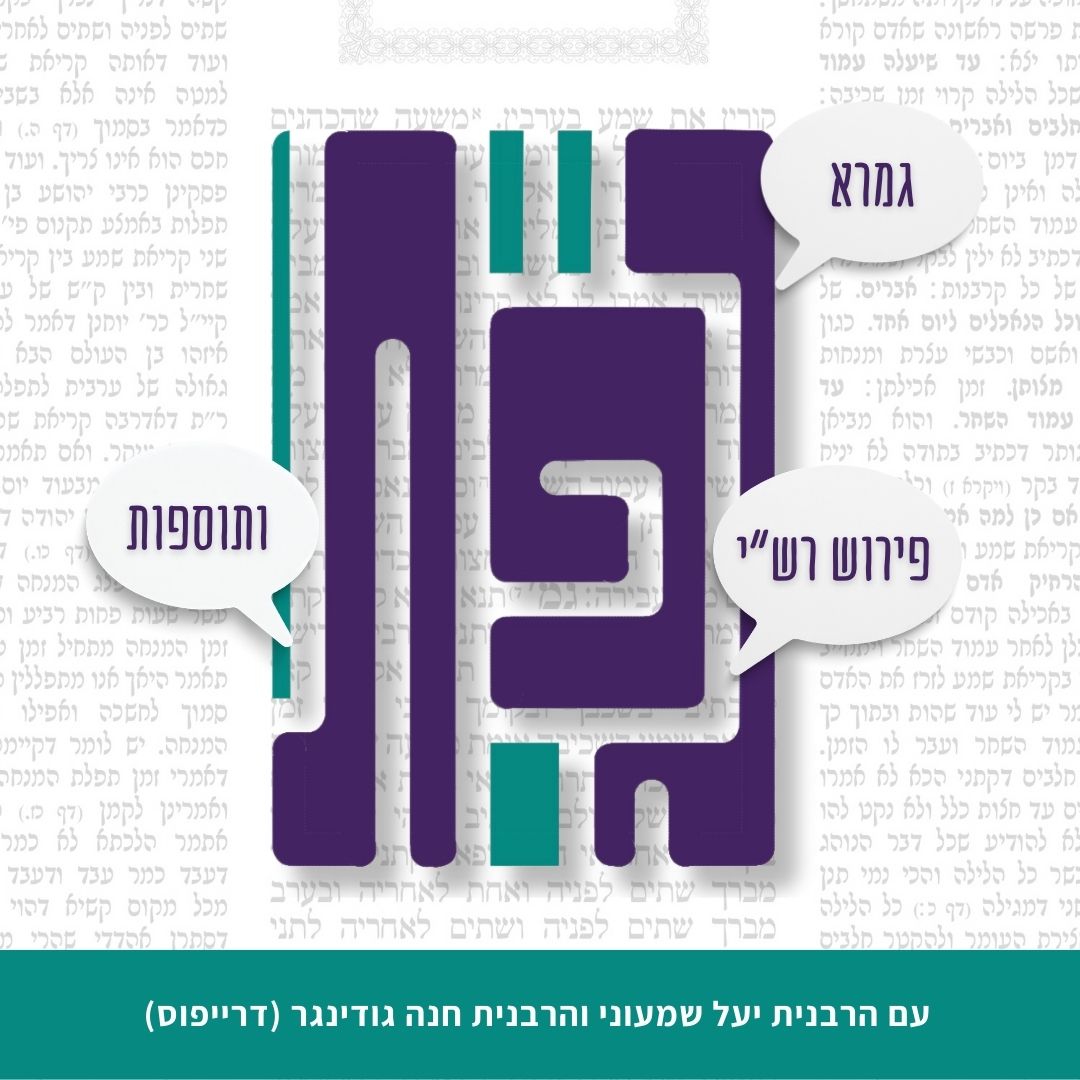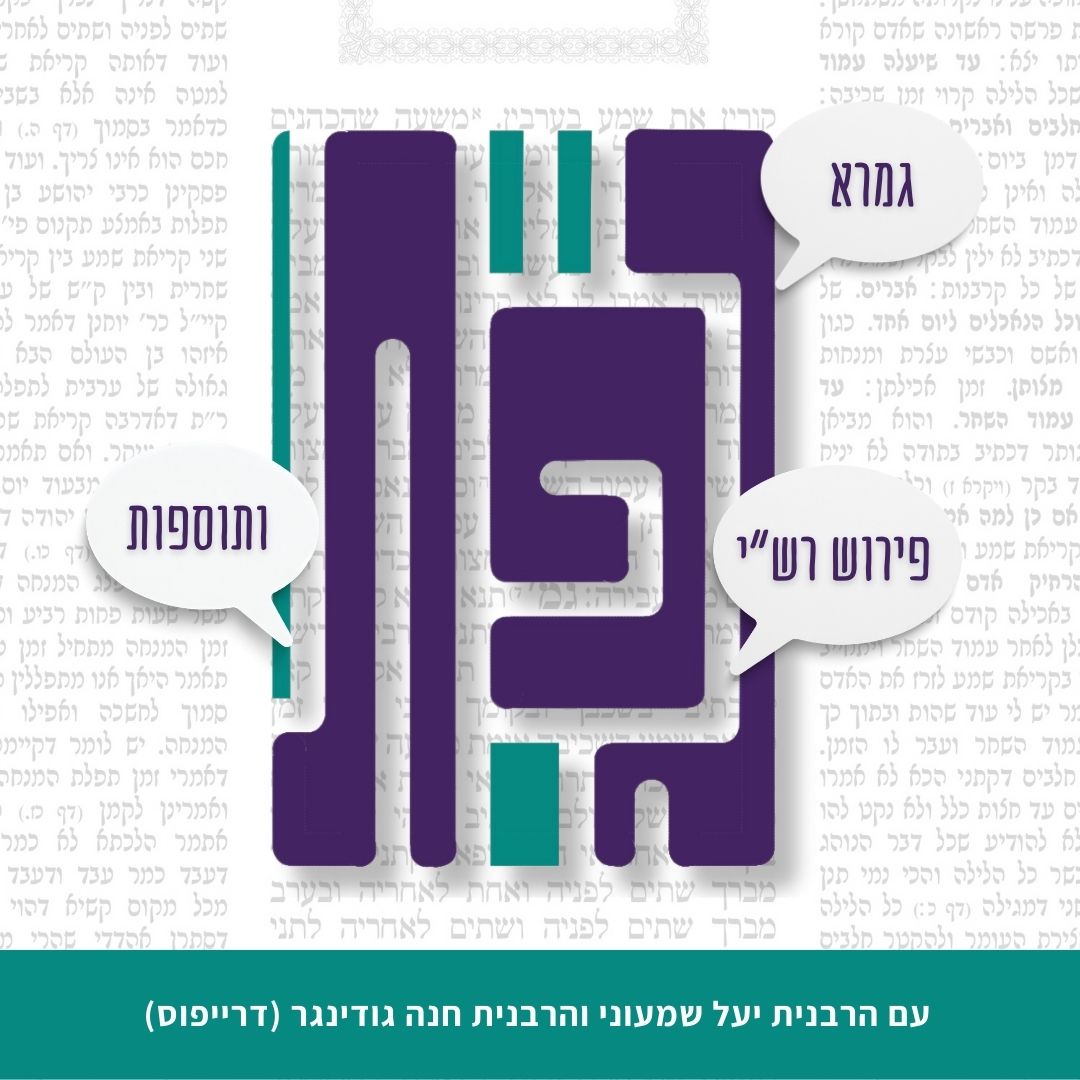הלימוד השבוע מוקדש ע”י רוברט ופאולה כהן לע”נ יוסף בן משה הכהן ז”ל. יוסף היה חזן שאהב מאוד לשיר, עבד קשה בחייו והיה מאוד מסור למשפחתו ולקהילה.
רוצה להקדיש שיעור?
כלים
הלימוד השבוע מוקדש ע”י רוברט ופאולה כהן לע”נ יוסף בן משה הכהן ז”ל. יוסף היה חזן שאהב מאוד לשיר, עבד קשה בחייו והיה מאוד מסור למשפחתו ולקהילה.
כלים
העמקה
רוצה להבין מה באמת קורה מתחת לפני השטח של הסוגיה?
שיעורים, פודקאסטים והרחבות של מיטב המורות שלנו יפתחו לך עוד זוויות וכיווני חשיבה.
חדשה בלימוד הגמרא?
זה הדף הראשון שלך? איזו התרגשות עצומה! יש לנו בדיוק את התכנים והכלים שיעזרו לך לעשות את הצעדים הראשונים ללמידה בקצב וברמה שלך, כך תוכלי להרגיש בנוח גם בתוך הסוגיות המורכבות ומאתגרות.
פסיפס הלומדות שלנו
גלי את קהילת הלומדות שלנו, מגוון נשים, רקעים וסיפורים. כולן חלק מתנועה ומסע מרגש ועוצמתי.
עבודה זרה מג
הָנֵי — אִין, צוּרַת דְּרָקוֹן — לָא!
The Sages interpret this verse as referring to the heavenly constellations, which indicates that it is prohibited to form only these figures, but it is not prohibited to form a figure of a dragon.
אֶלָּא פְּשִׁיטָא בְּמוֹצֵא, וּכְדִתְנַן: הַמּוֹצֵא כֵּלִים וַעֲלֵיהֶם צוּרַת חַמָּה.
Rather, the Gemara concludes, it is obvious that this halakha is referring to a case where one finds a vessel with the figure of a dragon, and this is as we learned in the mishna: In the case of one who finds vessels, and upon them is a figure of the sun, a figure of the moon, or a figure of a dragon, he must take them and cast them into the Dead Sea.
רֵישָׁא וְסֵיפָא בְּמוֹצֵא, וּמְצִיעֲתָא בְּעוֹשֶׂה?
The Gemara asks about the lack of consistency between the clauses of Rav Sheshet’s statement: Can it be that the first clause and the last clause are referring to a case where one finds vessels with the specified figures, and the middle clause is referring to a case where one forms these figures?
אָמַר אַבָּיֵי: אִין, רֵישָׁא וְסֵיפָא בְּמוֹצֵא, וּמְצִיעֲתָא בְּעוֹשֶׂה.
Abaye said: Indeed, the first clause and the last clause are referring to cases where one finds vessels with figures, and the middle clause is referring to a case where one forms figures.
רָבָא אָמַר: כּוּלָּהּ בְּמוֹצֵא, וּמְצִיעֲתָא רַבִּי יְהוּדָה הִיא. דְּתַנְיָא: רַבִּי יְהוּדָה מוֹסִיף אַף דְּמוּת מְנִיקָה וְסַר אֲפֵיס. מְנִיקָה — עַל שֵׁם חַוָּה שֶׁמְּנִיקָה כָּל הָעוֹלָם כּוּלּוֹ, סַר אֲפֵיס — עַל שֵׁם יוֹסֵף שֶׁסָּר וּמֵפִיס אֶת כָּל הָעוֹלָם כּוּלּוֹ. וְהוּא דְּנָקֵיט גְּרִיוָא וְקָא כָיֵיל, וְהִיא דְּנָקְטָא בֵּן וְקָא מְנִיקָה.
Rava said: The entire statement of Rav Sheshet is referring to a case where one finds vessels with these figures, and the middle clause is in accordance with the opinion of Rabbi Yehuda. As it is taught in a baraita that Rabbi Yehuda adds to the list of forbidden figures even a figure of a nursing woman and Sar Apis. The figure of a nursing woman is worshipped as it symbolizes Eve, who nurses the entire world. The figure of Sar Apis is worshipped as it symbolizes Joseph, who ruled over [sar] and appeased [mefis] the entire world by distributing food during the seven years of famine (see Genesis, chapter 41). But the figure of Sar Apis is forbidden only when it is holding a dry measure and measuring with it; and the figure of a nursing woman is forbidden only when she is holding a child and nursing it.
תָּנוּ רַבָּנַן: אֵיזֶהוּ צוּרַת דְּרָקוֹן? פֵּירֵשׁ רַבִּי שִׁמְעוֹן בֶּן אֶלְעָזָר: כֹּל שֶׁיֵּשׁ לוֹ צִיצִין בֵּין פְּרָקָיו. מַחְוֵי רַבִּי אַסִּי: בֵּין פִּרְקֵי צַוָּאר. אָמַר רַבִּי חָמָא בְּרַבִּי חֲנִינָא: הֲלָכָה כְּרַבִּי שִׁמְעוֹן בֶּן אֶלְעָזָר.
§ The Sages taught: What is a figure of a dragon? Rabbi Shimon ben Elazar explained: It is any figure that has scales between its joints. Rabbi Asi motioned with his hands to depict scales between the joints of the neck. Rabbi Ḥama, son of Rabbi Ḥanina, says: The halakha is in accordance with the opinion of Rabbi Shimon ben Elazar.
אָמַר רַבָּה בַּר בַּר חָנָה אָמַר רַבִּי יְהוֹשֻׁעַ בֶּן לֵוִי: פַּעַם אַחַת הָיִיתִי מְהַלֵּךְ אַחַר רַבִּי אֶלְעָזָר הַקַּפָּר בְּרִיבִּי בַּדֶּרֶךְ, וּמָצָא שָׁם טַבַּעַת וְעָלֶיהָ צוּרַת דְּרָקוֹן, וּמָצָא גּוֹי קָטָן וְלָא אָמַר לוֹ כְּלוּם, מָצָא גּוֹי גָּדוֹל וְאָמַר לוֹ: בַּטְּלָהּ, וְלֹא בִּטְּלָהּ, סְטָרוֹ וּבִטְּלָהּ.
Rabba bar bar Ḥana says that Rabbi Yehoshua ben Levi says: Once, I was following Rabbi Elazar HaKappar the Distinguished on the road, and he found a ring there, and there was a figure of a dragon on it. And he then encountered a minor gentile boy, but did not say anything to him. He then encountered an adult gentile, and said to him: Revoke the ring’s idolatrous status. But the gentile did not revoke it. Rabbi Elazar HaKappar then slapped him across his face, whereupon the gentile succumbed and revoked its idolatrous status.
שְׁמַע מִינַּהּ תְּלָת: שְׁמַע מִינַּהּ גּוֹי מְבַטֵּל עֲבוֹדָה זָרָה שֶׁלּוֹ וְשֶׁל חֲבֵירוֹ, וּשְׁמַע מִינַּהּ יוֹדֵעַ בְּטִיב שֶׁל עֲבוֹדָה זָרָה וּמְשַׁמְּשֶׁיהָ מְבַטֵּל, וְשֶׁאֵינוֹ יוֹדֵעַ בְּטִיב עֲבוֹדָה זָרָה וּמְשַׁמְּשֶׁיהָ אֵינוֹ מְבַטֵּל, וּשְׁמַע מִינַּהּ גּוֹי מְבַטֵּל בְּעַל כׇּרְחוֹ.
The Gemara comments: Learn from this incident the following three halakhot: Learn from it that a gentile can revoke the idolatrous status of both his object of idol worship and that of another gentile. And learn from the fact that Rabbi Elazar HaKappar waited to find an adult gentile, that only one who is aware of the nature of idol worship and its accessories can revoke the idol’s status, but one who is not aware of the nature of idol worship and its accessories, such as a minor, cannot revoke the idol’s status. And finally, learn from it that a gentile can revoke the status of an idol even against his will.
מְגַדֵּף בַּהּ רַבִּי חֲנִינָא, וְלֵית לֵיהּ לְרַבִּי אֶלְעָזָר הַקַּפָּר בְּרִיבִּי הָא דִּתְנַן: הַמַּצִּיל מִן הָאֲרִי וּמִן הַדּוֹב וּמִן הַנָּמֵר וּמִן הַגַּיִיס וּמִן הַנָּהָר וּמִזּוֹטוֹ שֶׁל יָם וּמִשְּׁלוּלִיתוֹ שֶׁל נָהָר, וְהַמּוֹצֵא בִּסְרַטְיָא וּפְלַטְיָא גְּדוֹלָה, וּבְכׇל מָקוֹם שֶׁהָרַבִּים מְצוּיִן שָׁם — הֲרֵי אֵלּוּ שֶׁלּוֹ, מִפְּנֵי שֶׁהַבְּעָלִים מִתְיָיאֲשִׁין מֵהֶן?
Rabbi Ḥanina ridiculed this ruling and asked: But why was it necessary to have a gentile actively revoke the idolatrous status of the ring? Doesn’t Rabbi Elazar HaKappar the Distinguished maintain in accordance with that which we learned in a baraita: In the case of one who saves an object from a lion, or from a bear, or from a cheetah, or from a troop of soldiers, or from a river, or from the tide of the sea, or from the flooding of a river, or similarly one who finds an object in a main thoroughfare or in a large plaza, or for that matter, anywhere frequented by the public, in all these cases, the objects belong to him, because the owners despair of recovering them? Therefore, in the case of a lost ring with an idolatrous figure on it, its idolatrous status is automatically revoked, as its owner despairs of recovering it.
אָמַר אַבָּיֵי: נְהִי דְּמִינַּהּ מִיָּיאַשׁ, מֵאִיסּוּרָא מִי מִיָּיאַשׁ? מֵימָר אָמַר: אִי גּוֹי מַשְׁכַּח לַהּ — מִפְלָח פָּלַח לַהּ, אִי יִשְׂרָאֵל מַשְׁכַּח לַהּ — אַיְּידֵי דְּדָמֶיהָ יְקָרִין מְזַבֵּין לַהּ לְגוֹי וּפָלַח לַהּ.
Abaye said: Granted, the owner despairs of recovering the object itself, but does he despair of its forbidden [me’issura] idolatrous status? The owner does not assume that the object will never be worshipped again; rather, he says to himself: If a gentile finds it, he will worship it. If a Jew finds it, since it is valuable, he will sell it to a gentile who will then worship it. Therefore, Rabbi Elazar HaKappar had to have the ring’s idolatrous status revoked.
תְּנַן הָתָם: דְּמוּת צוּרוֹת לְבָנוֹת הָיָה לוֹ לְרַבָּן גַּמְלִיאֵל בַּעֲלִיָּיתוֹ, בְּטַבְלָא בַּכּוֹתֶל, שֶׁבָּהֶן מַרְאֶה אֶת הַהֶדְיוֹטוֹת, וְאוֹמֵר לָהֶן: כָּזֶה רְאִיתֶם אוֹ כָּזֶה רְאִיתֶם?
§ We learned in a mishna there (Rosh HaShana 24a): Rabban Gamliel had diagrams of the different figures of moons drawn on a tablet that hung on the wall of his attic, which he would show to the ordinary people [hahedyotot] who came to testify about sighting the new moon but who were unable to adequately describe what they had seen. And he would say to them: Did you see an image like this, or did you see an image like that?
וּמִי שְׁרֵי? וְהָכְתִיב: ״לֹא תַעֲשׂוּן אִתִּי״, לֹא תַעֲשׂוּן כִּדְמוּת שַׁמָּשַׁי הַמְשַׁמְּשִׁים לְפָנַי!
The Gemara asks: And is it permitted to form these figures? But isn’t it written: “You shall not make with Me gods of silver, or gods of gold” (Exodus 20:20), which is interpreted to mean: You shall not make figures of My attendants who serve before Me, i.e., those celestial bodies that were created to serve God, including the sun and the moon.
אָמַר אַבָּיֵי: לֹא אָסְרָה תּוֹרָה אֶלָּא שַׁמָּשִׁין שֶׁאֶפְשָׁר לַעֲשׂוֹת כְּמוֹתָן,
In answering, Abaye said: The Torah prohibited only the figures of those attendants that one can possibly reproduce something that is truly in their likeness. Since it is impossible to reproduce the sun and the moon, the prohibition does not apply to these entities.
כִּדְתַנְיָא: לֹא יַעֲשֶׂה אָדָם בַּיִת תַּבְנִית הֵיכָל, אַכְסַדְרָה תַּבְנִית אוּלָם, חָצֵר תַּבְנִית עֲזָרָה, שׁוּלְחָן תַּבְנִית שׁוּלְחַן, מְנוֹרָה תַּבְנִית מְנוֹרָה, אֲבָל הוּא עוֹשֶׂה שֶׁל חָמֵשׁ וְשֶׁל שֵׁשׁ וְשֶׁל שְׁמוֹנֶה, וְשֶׁל שֶׁבַע לֹא יַעֲשֶׂה אֲפִילּוּ שֶׁל שְׁאָר מִינֵי מַתָּכוֹת.
As it is taught in a baraita: A person may not construct a house in the exact image of the Sanctuary, nor a portico in the exact image of the Entrance Hall of the Sanctuary, nor a courtyard corresponding to the Temple courtyard, nor a table corresponding to the Table in the Temple, nor a candelabrum corresponding to the Candelabrum in the Temple. But one may fashion a candelabrum of five or of six or of eight lamps. And one may not fashion a candelabrum of seven lamps even if he constructs it from other kinds of metal rather than gold, as in extenuating circumstances the Candelabrum in the Temple may be fashioned from other metals.
רַבִּי יוֹסֵי בַּר יְהוּדָה אוֹמֵר: אַף שֶׁל עֵץ לֹא יַעֲשֶׂה, כְּדֶרֶךְ שֶׁעָשׂוּ בֵּית חַשְׁמוֹנַאי.
The baraita continues: Rabbi Yosei bar Yehuda says: One may not fashion a candelabrum of wood either, in the manner that the kings of the Hasmonean monarchy fashioned it. When they first purified the Temple they had to fashion the Candelabrum out of wood as no other material was available. Since a wooden candelabrum is fit for the Temple, it is prohibited to fashion one of this kind for oneself.
אָמְרוּ לוֹ: מִשָּׁם רְאָיָה? שַׁפּוּדִין שֶׁל בַּרְזֶל הָיוּ, (וְחוֹפִין) [וְחִיפּוּם] בְּבַעַץ, הֶעֱשִׁירוּ — עֲשָׂאוּם שֶׁל כֶּסֶף, חָזְרוּ וְהֶעֱשִׁירוּ — עֲשָׂאוּם שֶׁל זָהָב.
The Rabbis said to Rabbi Yosei bar Yehuda: Do you seek to cite a proof from there, i.e., from the Hasmonean era, that a candelabrum fashioned of wood is fit for the Temple? During that era the branches of the Candelabrum were fashioned from spits [shappudin] of iron, and they covered them with tin [beva’atz]. Later, when they grew richer and could afford a Candelabrum of higher-quality material, they fashioned the Candelabrum from silver. When they grew even richer, they fashioned the Candelabrum from gold. In any event, Abaye proves from this baraita that the prohibition against forming a figure applies only to items that can be reconstructed in an accurate manner. Since this is not possible in the case of the moon, Rabban Gamliel’s figures were permitted.
וְשַׁמָּשִׁין שֶׁאִי אֶפְשָׁר לַעֲשׂוֹת כְּמוֹתָן מִי שְׁרֵי? וְהָתַנְיָא: ״לֹא תַעֲשׂוּן אִתִּי״ — לֹא תַעֲשׂוּן כִּדְמוּת שַׁמָּשַׁי הַמְשַׁמְּשִׁים לְפָנַי בַּמָּרוֹם!
The Gemara asks: And is it actually permitted to fashion figures of those attendants of God concerning which it is impossible to reproduce their likeness? But isn’t it taught in a baraita that the verse: “You shall not make with Me gods of silver” (Exodus 20:20), is interpreted to mean: You shall not make figures of My attendants who serve before Me on high? Apparently, this includes the sun and the moon.
אָמַר אַבָּיֵי:
Abaye said:
לֹא אָסְרָה תּוֹרָה אֶלָּא בִּדְמוּת אַרְבָּעָה פָּנִים בַּהֲדֵי הֲדָדֵי.
This does not include the sun and the moon, as the Torah prohibits the fashioning only of a figure of all four faces of the creatures of the Divine Chariot together (see Ezekiel 1:10). All other figures, which are not in the likeness of the ministering angels, are permitted.
אֶלָּא מֵעַתָּה, פַּרְצוּף אָדָם לְחוֹדֵיהּ תִּשְׁתְּרֵי! אַלְּמָה תַּנְיָא: כׇּל הַפַּרְצוּפוֹת מוּתָּרִין, חוּץ מִפַּרְצוּף אָדָם?
The Gemara raises a difficulty: If that is so, let the fashioning of a figure of a human face alone be permitted. Why then is it taught in a baraita: Figures of all faces are permitted, except for the human face?
אָמַר רַב יְהוּדָה בְּרֵיהּ דְּרַב יְהוֹשֻׁעַ: מִפִּרְקֵיהּ דְּרַבִּי יְהוֹשֻׁעַ שְׁמִיעַ לִי, ״לֹא תַעֲשׂוּן אִתִּי״ — לֹא תַעֲשׂוּן אוֹתִי, אֲבָל שְׁאָר שַׁמָּשִׁין שְׁרֵי.
Rav Yehuda, son of Rav Yehoshua, said: I heard in a lecture of Rabbi Yehoshua that there is a different reason why one may not fashion a figure of a human face; the verse states: “You shall not make with Me [iti]” (Exodus 20:20). This can be read as: You shall not make Me [oti]. Since the human being was created in the image of God (see Genesis 1:27), it is prohibited to fashion an image of a human being. But fashioning figures of other attendants of God is permitted.
וּשְׁאָר שַׁמָּשִׁין מִי שְׁרֵי? וְהָתַנְיָא: ״לֹא תַעֲשׂוּן אִתִּי״ — לֹא תַעֲשׂוּן כִּדְמוּת שַׁמָּשַׁי הַמְשַׁמְּשִׁין לְפָנַי בְּמָרוֹם, כְּגוֹן אוֹפַנִּים וּשְׂרָפִים וְחַיּוֹת הַקֹּדֶשׁ וּמַלְאֲכֵי הַשָּׁרֵת!
The Gemara asks: And is it permitted to fashion figures of other attendants of God? But isn’t it taught in another baraita that the verse: “You shall not make with Me gods of silver” (Exodus 20:20), is interpreted to mean that you shall not make figures of My attendants who serve before Me on high, for example, ofanim, and seraphim, and the sacred ḥayyot, and the ministering angels?
אָמַר אַבָּיֵי: לֹא אָסְרָה תּוֹרָה אֶלָּא שַׁמָּשִׁין שֶׁבַּמָּדוֹר הָעֶלְיוֹן.
Abaye said: The Torah prohibits fashioning figures of only those attendants that are in the upper heaven, i.e., the supreme angels in the highest firmament, but it does not prohibit fashioning the celestial bodies, e.g., the sun and the moon, despite the fact that they too are located in heaven.
וְשֶׁבְּמָדוֹר הַתַּחְתּוֹן מִי שְׁרֵי? וְהָתַנְיָא: ״אֲשֶׁר בַּשָּׁמַיִם״ — לְרַבּוֹת חַמָּה וּלְבָנָה כּוֹכָבִים וּמַזָּלוֹת, ״מִמַּעַל״ — לְרַבּוֹת מַלְאֲכֵי הַשָּׁרֵת!
The Gemara asks: And is it permitted to fashion figures of those bodies that are in the lower heaven? But isn’t it taught in a baraita with regard to the verse: “You shall not make for yourself any graven image, nor any manner of likeness, of anything that is in heaven above, or that is in the earth beneath, or that is in the water under the earth” (Exodus 20:4): The phrase “that is in heaven” serves to include the sun, and the moon, the stars, and the constellations. The term “above” serves to include the ministering angels. Apparently, it is prohibited to fashion a figure even of the celestial bodies that are in the lower heaven.
כִּי תַּנְיָא הָהִיא, לְעוֹבְדָם.
The Gemara answers: When that baraita is taught, it is in reference to the prohibition against worshipping them. There is no prohibition against forming a figure in their likeness.
אִי לְעוֹבְדָם, אֲפִילּוּ שִׁילְשׁוּל קָטָן נָמֵי! אִין הָכִי נָמֵי, וּמִסֵּיפֵיהּ דִּקְרָא נָפְקָא, דְּתַנְיָא: ״אֲשֶׁר בָּאָרֶץ״ — לְרַבּוֹת יַמִּים וּנְהָרוֹת הָרִים וּגְבָעוֹת, ״מִתַּחַת״ — לְרַבּוֹת שִׁילְשׁוּל קָטָן.
The Gemara asks: If that baraita is referring to the prohibition against worshipping them, then why does it mention only celestial bodies? It is prohibited to worship even a tiny worm. The Gemara answers: Yes, it is indeed so; and this prohibition is derived from the latter clause of that verse, as it is taught in a baraita: “That is in the earth” serves to include seas, and rivers, mountains, and hills. The word “beneath” serves to include a tiny worm.
וַעֲשִׂיָּיה גְּרֵידְתָּא מִי שְׁרֵי? וְהָתַנְיָא: ״לֹא תַעֲשׂוּן אִתִּי״ — לֹא תַעֲשׂוּן כִּדְמוּת שַׁמָּשַׁי הַמְשַׁמְּשִׁין לְפָנַי בַּמָּרוֹם, כְּגוֹן: חַמָּה וּלְבָנָה, כּוֹכָבִים וּמַזָּלוֹת.
The Gemara asks: And is the mere fashioning of figures of the celestial bodies permitted? But isn’t it taught in another baraita that the verse: “You shall not make with Me gods of silver” (Exodus 20:20), is interpreted to mean that you shall not make figures of My attendants who serve before Me on high, for example: The sun, and the moon, the stars, and the constellations. This is proof that it is prohibited to fashion figures of the sun and the moon. Consequently, the solution proposed by Abaye is rejected, leaving the difficulty of Rabban Gamliel’s diagram unresolved.
שָׁאנֵי רַבָּן גַּמְלִיאֵל, דַּאֲחֵרִים עָשׂוּ לוֹ.
The Gemara proposes an alternative resolution: The case of Rabban Gamliel is different, as others, i.e., gentiles, fashioned those figures for him, and it is prohibited for a Jew only to fashion such figures; there is no prohibition against having them in one’s possession.
וְהָא רַב יְהוּדָה, דַּאֲחֵרִים עָשׂוּ לוֹ, וַאֲמַר לֵיהּ שְׁמוּאֵל לְרַב יְהוּדָה: שִׁינָּנָא, סַמִּי עֵינֵיהּ דְּדֵין!
The Gemara asks: But there is the case of Rav Yehuda, where others fashioned for him a seal with a figure of a person on it, and Shmuel said to Rav Yehuda, who was his student: Sharp-witted one [shinnana], destroy this one’s eyes, i.e., disfigure it, as it is prohibited even to have a figure of a human being in one’s possession.
הָתָם בְּחוֹתָמוֹ בּוֹלֵט, וּמִשּׁוּם חֲשָׁדָא, דְּתַנְיָא: טַבַּעַת שֶׁחוֹתָמָהּ בּוֹלֵט — אָסוּר לְהַנִּיחָהּ, וּמוּתָּר לַחְתּוֹם בָּהּ. חוֹתָמָהּ שׁוֹקֵעַ — מוּתָּר לְהַנִּיחָהּ, וְאָסוּר לַחְתּוֹם בָּהּ.
The Gemara answers: There, in the case of Rav Yehuda, his was a protruding seal, i.e., the figure projected from the ring, and Shmuel prohibited it due to the potential suspicion that he had an object of idol worship in his possession. As it is taught in a baraita: In the case of a ring whose seal protrudes, it is prohibited to place it on one’s finger due to suspicion of idol worship, but it is permitted to seal objects with it. In this case, the act of sealing forms a figure that is sunken below the surface of the object upon which the seal was impressed, which is not prohibited. If its seal is sunken, it is permitted to place it on one’s finger, but it is prohibited to seal objects with it, as that forms a protruding figure.
וּמִי חָיְישִׁינַן לַחֲשָׁדָא? וְהָא בֵּי כְנִישְׁתָּא דְּשַׁף וִיתֵיב בִּנְהַרְדְּעָא, (דְּאוֹקְמִי) [דְּאוֹקִימוּ] בֵּיהּ אִנְדְּרָטָא, וַהֲווֹ עָיְילִי בֵּיהּ אֲבוּהּ דִּשְׁמוּאֵל וְלֵוִי וּמְצַלּוּ בְּגַוֵּיהּ, וְלָא חָיְישִׁי לַחֲשָׁדָא! רַבִּים שָׁאנֵי.
The Gemara asks: And are we concerned about arousing suspicion due to the use of a human figure? But what about that synagogue that had been destroyed in Eretz Yisrael and was reestablished in Neharde’a, and they erected a statue of the king in it? And nevertheless, Shmuel’s father and Levi would enter and pray in it, and they were not concerned about arousing suspicion. The Gemara answers: A public institution is different; the public is not suspected of having idolatrous intentions. Rather, it is assumed that the statue is there exclusively for ornamental purposes.
וְהָא רַבָּן גַּמְלִיאֵל דְּיָחִיד הֲוָה? כֵּיוָן דְּנָשִׂיא הוּא, שְׁכִיחִי רַבִּים גַּבֵּיהּ. וְאִיבָּעֵית אֵימָא: דִּפְרָקִים הֲוַאי.
The Gemara asks: But wasn’t Rabban Gamliel an individual? According to this reasoning, his figures of the moon should have been forbidden as they would have aroused suspicion. The Gemara answers: Since he was the Nasi, the head of the Sanhedrin, members of the public would often be found with him, and therefore there was no room for suspicion. And if you wish, say there is an alternative answer, namely, that these figures were not whole; rather, they were formed from pieces of figures that had to be assembled. Only complete figures are forbidden.
וְאִיבָּעֵית אֵימָא, לְהִתְלַמֵּד שָׁאנֵי, דְּתַנְיָא: ״לֹא תִלְמַד לַעֲשׂוֹת״, אֲבָל אַתָּה לָמֵד לְהָבִין וּלְהוֹרוֹת.
And if you wish, say there is yet another answer: Fashioning figures in order to teach oneself is different, as it is taught in a baraita with regard to the verse: “You shall not learn to do like the abominations of those nations” (Deuteronomy 18:9): But you may learn in order to understand the matter yourself and teach it to others. In other words, it is permitted to perform certain acts for the sake of Torah study that would otherwise be prohibited.
רַבָּן שִׁמְעוֹן בֶּן גַּמְלִיאֵל אוֹמֵר וְכוּ׳. אֵיזוֹ הֵן מְכוּבָּדִין, וְאֵיזוֹ הֵן מְבוּזִּין?
§ The mishna (42b) teaches that Rabban Shimon ben Gamliel says: Those figures that are upon respectable vessels are forbidden. Those that are upon disgraceful vessels are permitted. The Gemara asks: Which vessels are considered respectable and which are considered disgraceful?
אָמַר רַב: מְכוּבָּדִין — לְמַעְלָה מִן הַמַּיִם, מְבוּזִּין — לְמַטָּה מִן הַמַּיִם. וּשְׁמוּאֵל אָמַר: אֵלּוּ וָאֵלּוּ מְבוּזִּין הֵן, אֶלָּא אֵלּוּ הֵן מְכוּבָּדִין — שֶׁעַל הַשֵּׁירִין וְעַל הַנְּזָמִים וְעַל הַטַּבָּעוֹת.
Rav says: These terms do not represent different types of vessels, but rather the location of the figure upon the vessel. A respectable location for an idolatrous figure is on the side of the vessel above the level of the water or food contents; a disgraceful location is below the water level. And Shmuel says: Both these and those locations on eating utensils are disgraceful. Rather, these are respectable locations: Upon bracelets, or upon nose rings, or upon rings.
תַּנְיָא כְּוָותֵיהּ דִּשְׁמוּאֵל: מְכוּבָּדִין — שֶׁעַל הַשֵּׁירִין, וְעַל הַנְּזָמִים, וְעַל הַטַּבָּעוֹת; מְבוּזִּין — שֶׁעַל הַיּוֹרוֹת, וְעַל הַקּוּמְקְמֹסִין, וְעַל מְחַמֵּי חַמִּים, וְשֶׁעַל הַסְּדִינִין, וְעַל הַמִּטְפָּחוֹת.
The Gemara comments: It is taught in a baraita in accordance with the opinion of Shmuel (Tosefta 5:1): Respectable locations for idolatrous figures are upon bracelets, or upon nose rings, or upon rings. Disgraceful locations are upon large pots, or upon small kettles [hakumkemasin], or upon samovars, or upon sheets, or upon towels.
מַתְנִי׳ רַבִּי יוֹסֵי אוֹמֵר: שׁוֹחֵק וְזוֹרֶה לָרוּחַ, אוֹ מֵטִיל לַיָּם. אָמְרוּ לוֹ: אַף הוּא נַעֲשֶׂה זֶבֶל, שֶׁנֶּאֱמַר: ״לֹא יִדְבַּק בְּיָדְךָ מְאוּמָה מִן הַחֵרֶם״.
MISHNA: Rabbi Yosei says: When one encounters an idol, he should grind the idol and throw the dust to the wind or cast it into the sea. The Rabbis said to him: What is the good of that? That also gives a Jew benefit from the idol, as it becomes fertilizer for his crops, and deriving any kind of benefit is prohibited, as it is stated: “And nothing of the proscribed items shall cleave to your hand” (Deuteronomy 13:18).
גְּמָ׳ תַּנְיָא, אָמַר לָהֶם רַבִּי יוֹסֵי, וַהֲלֹא כְּבָר נֶאֱמַר: ״וְאֶת חַטַּאתְכֶם
GEMARA: It is taught in a baraita (Tosefta 3:16): Rabbi Yosei said to them: But isn’t it already stated: “And your sin,























